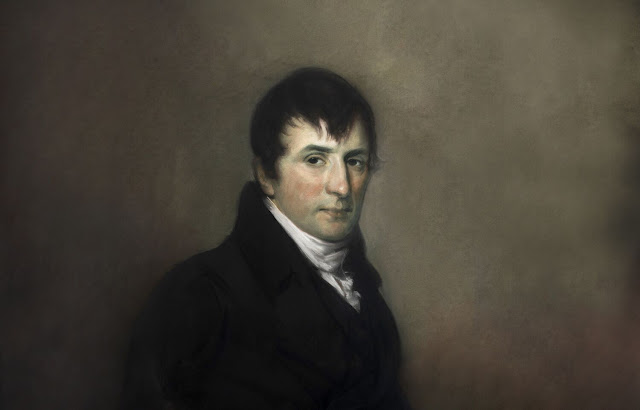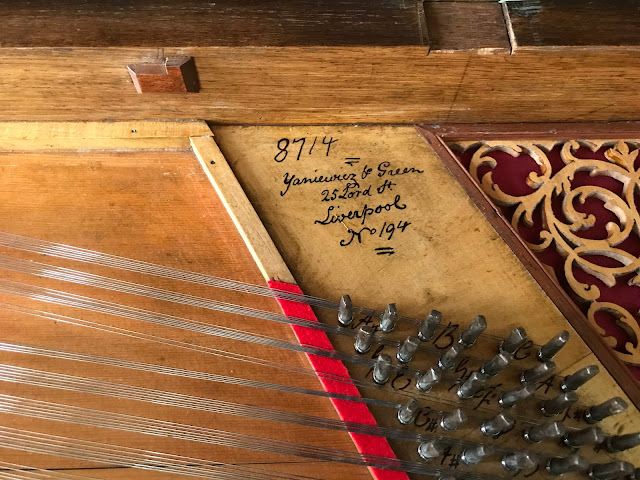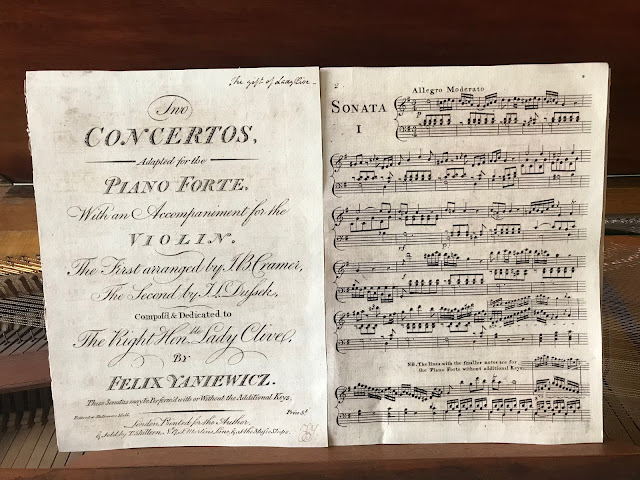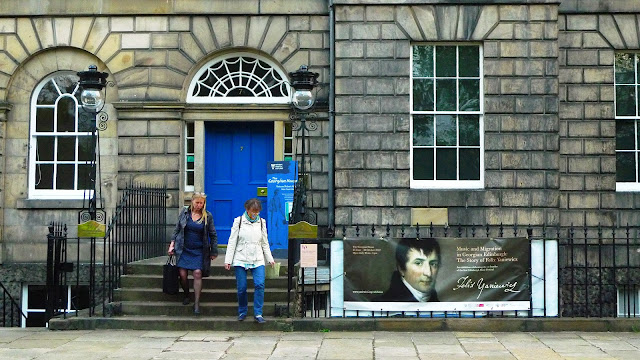Felix Yaniewicz - Music and Migration in Georgian Edinburgh - A remarkable discovery
I traveled to Edinburgh towards the end of June 2022 and among the many adventures and museums visited, I managed to be there for the opening of this remarkable exhibition at the Georgian House. I live in Warsaw in Poland, move in musical circles there, but had never encountered this artist. I was astounded at the discovery.
I met and had a long instructive conversation with the exhibition curator Josie Dixon who assembled and wrote an excellent article on Felix Yaniewicz, her ancestor and a Polish virtuoso violinist, composer and businessman who was the catalyzing founding force behind the present, world-renowned, Edinburgh Festival. But this was in 1815 !
Felix Yaniewicz
Music and Migration in Georgian Edinburgh
Written by Josie Dixon, Curator of Music and Migration in Georgian Edinburgh
 |
| Felix Yaniewicz (1823-1848) | Image courtesy of The Friends of Felix Yaniewicz |
Visitors exploring Edinburgh’s
New Town may find themselves walking past 84 Great King St, where an
inscription on a cornerstone by the door records, ‘Felix Yaniewicz, Polish
composer and musician, co-founder of First Edinburgh Music Festival, lived and
died here 1823–1848’.
The story behind this inscription
has remained untold until now, but between 25 June–22 October 2022 you could see
an exhibition at the Georgian House on Yaniewicz’s remarkable life celebrating his musical legacy in Scotland. It showcased a unique collection of musical instruments, portraits, silver and gold
heirlooms, letters and manuscripts, offering a fascinating insight into the
career of this charismatic performer, composer and impresario who left a
lasting mark on Scottish musical culture. The associated talks and events highlighted the cosmopolitan roots of Scottish heritage, and the vital role of migration
in shaping the cultural life of Georgian Edinburgh.
 |
| 84 King Street, Edinburgh where Felix Janiewicz lived (Image Michael Moran) |
 |
| Felix Yaniewicz Commemorative Plaque at 84 King Street, Edinburgh (Image Michael Moran) |
The project came about with the chance discovery of a beautiful square piano, dated around 1810. It was found in dilapidated condition in a private house in Snowdonia by Douglas Hollick, an expert on early keyboard instruments, who recognized its historical significance and potential for restoration. Above the keyboard, a gilded cartouche with painted flowers and musical instruments bears the label ‘Yaniewicz & Green’, with addresses in fashionable areas of London and Liverpool.
 |
| Yaniewicz & Green Square Piano in the Drawing Room of the Georgian House, Edinburgh (Image Michael Moran) |
 |
| Inscription inside the piano written by Yaniewicz (Image Michael Moran) |
Watch now: the Yaniewicz
& Green square piano
Inside the piano, the signature
in Indian ink has been matched with the marriage certificate of Felix
Yaniewicz, a Polish-Lithuanian violin virtuoso and composer, who fled the continent
during the French Revolution and settled in Britain.
Some years later, newly restored
as a working instrument, the piano was put up for sale, and by chance the advertisement
was spotted by one of Yaniewicz’s surviving descendants. ‘It was a thrilling
moment,’ recalls Josie Dixon. ‘Yaniewicz was my
great-great-great-great-grandfather. When I was growing up, his portrait hung
in my grandmother’s cottage: a handsome, enigmatic presence with more than a
touch of Mr Darcy.’
Quote:
“At the time, I knew little of
his life, but discovering this instrument with a very direct connection to my
ancestor inspired me to find out more about his story.”
Josie Dixon
Exhibition curator and descendant
of Felix Yaniewicz
Josie hatched a plan for a
crowdfunding campaign, to save the piano from falling into private hands and to
bring it to Edinburgh to mark Yaniewicz’s musical legacy in Scotland. The
project became a collaboration with the Scottish Polish Cultural Association,
and funds were raised from all over Britain, Poland, Germany, Norway, France,
Italy, Switzerland and the USA. Donors included the composer Roxana Panufnik,
marking over 200 years of Polish musical heritage in Britain.
The final donation was made by an
Edinburgh doctor in memory of her father, Stanislaw Zawerbny, a Polish veteran,
with funds collected at his 100th birthday, and afterwards at his funeral – a
poignant indication of how this project had been taken to heart in the Scottish
Polish community. The Polish Ex-Combatants’ Association offered to house the
piano at their former club house on Drummond Place, just around the corner from
Yaniewicz’s residence on Great King Street.
On 10 November 2021, the piano began its journey north from the restorer’s workshop in Lincolnshire to its new home in Edinburgh. Its arrival was celebrated with two inaugural recitals by Steven Devine and Pawel Siwczak, setting Yaniewicz’s music in the context of contemporary composers from across Europe, and from his native Poland.
 |
| The Drawing Room of the Georgian House, Edinburgh, where the piano is displayed |
This summer of 2022, the piano
will make a shorter journey for the exhibition at the Georgian House, where it
will be on display alongside family heirlooms which were passed down the
generations among Yaniewicz’s descendants and have never been seen in public
before. These musical instruments, portraits, personal possessions and letters
have a remarkable story to tell, about the life of a celebrated musician who
changed the course of Scottish musical history.
He was born Feliks Janiewicz in
1762 in Vilnius (then part of the Polish-Lithuanian Commonwealth), and rose to
prominence as a performer in the Polish Royal chapel. King Stanislaus August
Poniatowski, a great patron of the arts, paid for him to travel to Vienna,
where he encountered Haydn and Mozart.
 |
| ‘Janievitz’ from Professori Celebri Del Suono | AKG images / Berlin Sammlung Archiv für Kunst und Geschichte |
Mozart’s 19th-century biographer
Otto Jahn speculates that his lost Andante in A major K470 written at this time
may have been composed for Yaniewicz. Michael Kelly, a famous tenor, wrote that
while in Vienna he was privileged to hear one of the foremost violinists in the
world: ‘...a very young man, in the service of the King of Poland, he touched
the instrument with thrilling effect, and was an excellent leader of an
orchestra. His concertos always finished with some pretty Polonaise air; his
variations were truly beautiful.’
Yaniewicz travelled to Italy and
then to Paris, where he made his concert debut in 1787, and found a patron in
the Duke of Orléans. But these were turbulent times, and a few years later,
with France in revolution and his native land in political meltdown, he fled to
Britain as a refugee and joined a community of musical emigrés in London.
There he played in Salomon’s
orchestra, conducted by Haydn, performing solo concertos at the Hanover Square
Rooms in 1792. In Bath later that year, he was hailed as ‘the celebrated Mr
Yaniewicz’ – now spelling his name with the anglicized Y which he adopted for
the rest of his life, perhaps signalling his desire to assimilate and a
decision to settle in Britain.
The lost Stradivarius
Yaniewicz was effectively what one might term a refugee musician in Britain but he had managed to salvage his precious violins. He owned a beautiful inlaid double violin case (on display in the exhibition). The architect Charles Harrison Townsend, his grandson, wrote a family inventory of effects in 1925 among which is described the destiny of two Yaniewicz violins.
'His Strad he sold for £60, about 1845 (£8,100 in 2022) See his own letter on the subject ... This violin was (so says the violin-expert A. Hill of Bond Street - who knows it well) a celebrated instrument and is now in the possession of a New York collector, well known to Hill. His Amati was raffled for, and produced 40 guineas!'
The present whereabouts of the Stradivarius and Amati, the sounds of which had seduced audiences in Britain, remain a mystery.
 |
| The inlaid double violin case that may have contained the Stradivarius and Amati instruments owned by Yaniewicz. A silver table bell to the right (Image Michael Moran) |
He toured the country as a
charismatic performer and energetic impresario, playing concerts in fashionable
cities, including Dublin where his concert series in 1799 was billed as ‘Mr
Yaniewicz’s Nights’. In London he was a founder member of the Philharmonic
Society (marking a pivotal moment in the transition from the patronage system
to musical meritocracy) and mounted the first British performance of
Beethoven’s oratorio, Christ on the Mount of Olives.
 |
Framed drawing of Eliza Yaniewicz (nee Breeze) by an unknown artist, no date |
In 1799 Yaniewicz moved to
Liverpool and married an Englishwoman, Eliza Breeze. Cutting a dash on the
social scene, he caught the attention of The Monthly Mirror: ‘...he combines
the utile with the dolce. He is married at Liverpool; leads the concerts; and
is (à la Liverpool) a man of business.’
By the end of 1800 he was also a
family man, with a daughter Felicia (the first of three children to survive
beyond infancy), so a steady income was called for. A business dealing in
musical instruments marked a new strand to his portfolio. In 1801 he opened a
warehouse in Lord Street, one of two premises for this enterprise, in
partnerships with John Green and a London pianoforte maker, Thomas Loud.
 |
| The address label on the 1810 square piano for ‘Yaniewicz & Green’ (Image Michael Moran) |
The Yaniewicz & Green square
piano bears the hallmarks of the London workshop of Clementi, the foremost
piano manufacturer of the day. A fellow émigré and composer, Clementi had met
Yaniewicz in the 1790s in London. They appear together around the same dining
table in the diary of the political philosopher William Godwin, who records
that quartets were played after dinner.
By the early 1800s they were in
business together. Clementi’s firm made the instruments, while Yaniewicz and
partners would have ordered customised designs for their fashionable clients in
London and Liverpool, using his celebrity status to enhance the brand of their
retail operation. Another survival of their collaboration is the beautiful
Apollo lyre guitar, now in the Royal Albert Memorial Museum in Exeter.
An Apollo Lyre Guitar, made by Yaniewicz and Company in Liverpool c.1800. On loan to the exhibition at the Georgian House from The Royal Albert Museum in Exeter (Image Michael Moran) |
Yaniewicz, however, was moving
north. He had first given touring concerts in Edinburgh in 1804, and was
immediately a sensation. Three subscription concerts at Corri’s Rooms were
followed by a benefit concert, at which his performance was hailed as ‘...a
perfect masterpiece of the art. In fire, spirit, elegance and finish, Mr Yaniewicz’s
violin concerto cannot be excelled by any performance in Europe.’
So perhaps it was not surprising
that it was in Edinburgh that he undertook his boldest initiative, as
co-founder of the first music festival in October 1815. An article by Karen Macaulay
has shown that the idea originated with Angelica Catalani – the operatic
superstar of the day, with whom Yaniewicz had a long collaboration on the
concert platform, from as early as 1807 until her retirement in 1824.*
Read
more: A lady’s diary of the first Edinburgh Musical Festival
In 1814 Mme Catalani set out in
an advertisement in the Caledonian Mercury bold plans for an event on which she
failed to deliver, but Yaniewicz and his colleagues brought off the 1815
festival in style. Before the year was out, he and Eliza moved to Scotland and
made Edinburgh their home for good.
 |
| Angelica Catalani (1780-1849) by Rolinda Sharples (1793-1838) |
* Michael Moran adds that on November 21, 1819, Angelica Catalani appeared in Warsaw. She stayed at the elegant home of one of her relatives, Konstanty Wolicki. The ten year old Chopin heard La Catalani sing, perhaps igniting the fire of his passion for opera. Naturally, she requested he play. She was so enchanted by his performance she presented him with a gold pocket watch, now a precious inscribed relic in the Chopin Museum in Warsaw.
 |
| Title page from George Farquhar Graham’s An Account of the First Edinburgh Music Festival (Edinburgh, 1816) Image courtesy of The Friends of Felix Yaniewicz |
Among the memorabilia on display will be a first edition of An Account of the First Edinburgh Music Festival 1815 by one of its secretaries, George Farquhar Graham. The volume is inscribed on the flyleaf ‘To Mrs Yaniewicz, as a small mark of the author’s esteem and friendship.’ It contains a long list of the festival’s aristocratic patrons, the programmes for every concert, and Farquhar Graham’s lengthy reviews of the performances, together with ‘an essay containing some general observations on music’.
Farquhar Graham’s account gives
an evocative insight into the atmosphere and excitement surrounding the
festival, captured in this description of the build-up to the first concert in
Parliament Hall:
‘...the large and beautiful
orchestra filled with eminent performers; the multitude of well-dressed persons
occupying the gallery… the novelty of the occasion; the spaciousness of the
place whose high walls, and massive sober ornaments were illuminated by the
bright beams of the morning sun; together with the expectations of the serious
and magnificent entertainment which was about to commence powerfully
contributed to produce in every one a state of mental elevation and delight,
rarely to be experienced.’
Grand concerts in Parliament Hall combined major oratorios – Haydn’s Creation and Handel’s Messiah – with operatic arias, Haydn symphonies and Yaniewicz’s violin concertos.
 |
| (Image Michael Moran) |
Evening
concerts were in Corri’s Rooms, a private concert venue established by the
Italian Natale Corri (brother of Domenico Corri who had moved to Edinburgh in
1771 to direct the concerts of the Edinburgh Music Society in St Cecilia’s
Hall). These concerts may have been smaller in scale, but were scarcely less
ambitious, featuring symphonies by Mozart and Beethoven as well as another of
Yaniewicz’s violin concertos. This was a formidable amount of music for the
same group of performers to present in the space of a few days, and Yaniewicz
led the orchestra throughout.
Farquhar Graham’s introduction
presents the festival as a turning point in Scottish musical taste, moving away
from national folk culture and towards the classical, continental tradition
that Yaniewicz represented, trailing clouds of musical glory from his
encounters with Haydn and Mozart in Vienna.
At the end of his preface,
Farquhar Graham dared to speculate about the legacy of this foundational event
in the nation’s musical culture, in a moment that seems to court posterity:
‘...it has excited much temporary interest – and it may be followed by
important consequences, at a time when the hand that now attempts to describe
its immediate effects, and the hearts of all who participated in its pleasures,
are mouldered into dust.’
If the founders of the Edinburgh
International Festival, in the aftermath of the Second World War, can be seen
as the successors of their counterparts in 1815, Farquhar Graham’s prediction
has been more richly fulfilled than he could ever have imagined.
More immediately, the 1815
festival gave rise to the Edinburgh Institution for the encouragement of Sacred
Music, established on 28 December 1816. The report on their annual general
meeting, chaired by the Lord Provost, echoes Farquhar Graham, deploring
Scotland’s ‘national deficiency’ in the realm of sacred music, seen as a
touchstone of civilisation. The Scottish attachment to folk music was held
responsible for ‘a certain prejudice which still exists against any departure
from the naked simplicity of our earliest melodies. The native musical taste of
Scotland can hardly be said to relish the charms of harmony’. The report hails
the previous year’s events as pivotal in Scotland’s emergence from this
backward state:
‘It was the musical festival of
1815, which gave a new turn in this quarter, to the general feeling on the
subject of sacred music: and […] laid the foundation for an improved taste in
this country. Those splendid performances, in which variety, richness, and
elegance, were so remarkably combined, filled the audience with emotions, which
probably had never before been excited in Scotland by the power of music.’
It goes on to record the
Institution’s concerts in 1816–17, in which ‘the effect […] was increased by
the admirable talents of Mr Yaniewicz, who on this occasion obligingly
consented to lead the band, and has ever since given his powerful assistance,
both at the rehearsals and public performances.’ It ends by predicting that the
establishment of this new institution ‘will be justly regarded by future times
as a new era in the musical history of Scotland.’
The year after the 1815 festival,
Corri retired as Edinburgh’s chief concert promoter and Yaniewicz was the
obvious choice to succeed him. He instituted a series of ‘morning concerts’ of
chamber music (actually at 2pm), ‘attended by a numerous and fashionable
audience’. Later, in the 1820s, these Monday concerts were moved to Saturdays,
suggesting a shift in his clientele from the leisured upper echelons of
Edinburgh society to the professional classes.
 |
Yaniewicz’s gravestone can be found in Warriston cemetery in Edinburgh |
1829 saw Yaniewicz’s farewell concert in Edinburgh, after which he began to disappear from public view. But it is tempting to wonder whether he crossed paths with another Felix who visited the city that year, on his way to a tour of the Highlands and the Hebrides. Mendelssohn stayed in the city for four days in July 1829, climbing Arthur’s Seat and finding the first inspiration for his Scottish Symphony in the ruined Abbey of Holyrood Palace. He stayed in Albany Street, a 10-minute walk from Yaniewicz’s residence, and it is not difficult to imagine that Yaniewicz would have been a guest at one of the soirées organised for Mendelssohn’s visit.
He lived at Great King Street for almost two more decades,
though sadly not quite long enough to encounter his compatriot Chopin, who
visited Scotland in the autumn of 1848. Only a few months after, Yaniewicz died
in May of that year. Until the very end of his life he embraced nostalgia for his Lithuanian birthplace, Vilnius, and the country's national identity, even having his cutlery and gold seal fob engraved with the Crest and Motto PRO LITHUANIA.
Yaniewicz is buried in Warriston
Cemetery, where his gravestone commemorates ‘a most eminent and accomplished
musician […] honoured, loved and regretted’. A fitting obituary can be found
in Noctes Ambrosianae, published in Blackwoods Magazine in 1826:
‘Let Yaniewicz, and Finlay Dun and Murray, play solos of various kinds – divine airs of the great old masters, illustrious or obscure – airs that may lap the soul in Elysium. Let them also, at times, join their eloquent violins, and harmoniously discourse in a celestial colloquy: they are men of taste, feeling, and genius.’
* * * * * * * * * *
 |
| Josie Dixon (Lt.) Curator of Music and Migration in Georgian Edinburgh leaving The Georgian House Exhibition Sunday 26 June 2022 (Image Michael Moran) |





Comments
Post a Comment